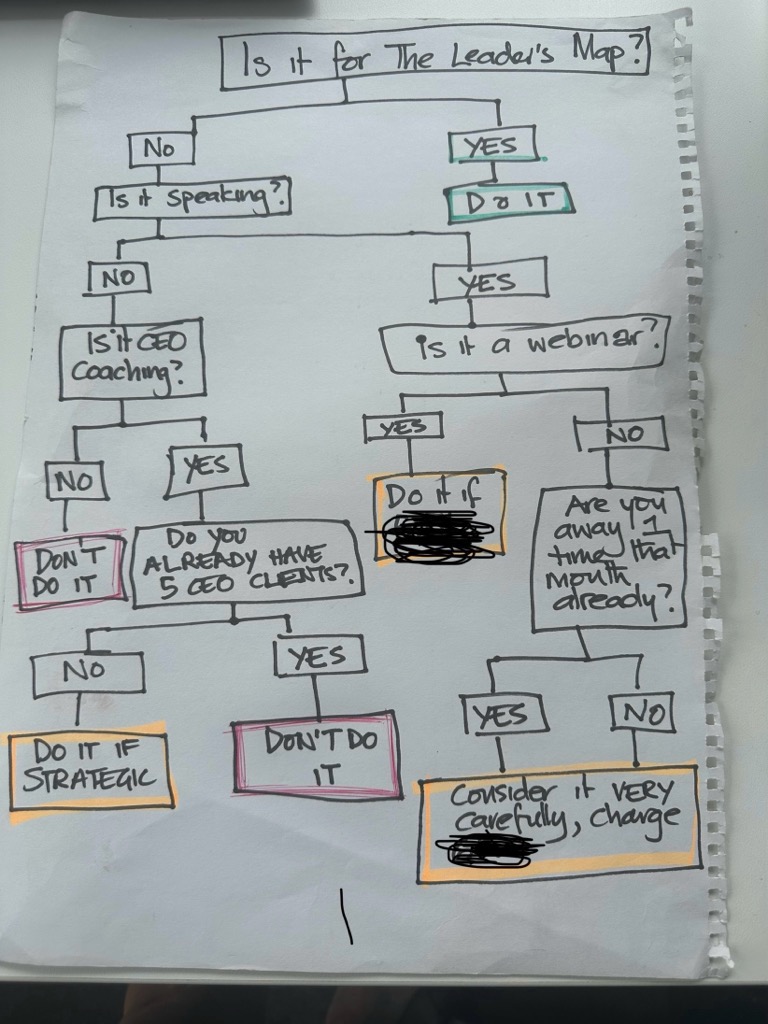The average adult makes between 33,000 and 35,000 decisions a day. If you’re in a leadership role, you probably make even more than that. McKinsey research found that if you’re an executive, you could be spending nearly 40% of your day making decisions.
Decision fatigue is a thing. It’s when our ability to make decisions and control behaviour is impaired as a consequence of repeated acts of decision making. Anything that can alleviate this has got to be worth a try, right?
So, this year I started an experiment: creating and using a Decision-Making Tree when it comes to prioritising. Any time an opportunity for business comes my way, and before I accept any invitation for work, I have to test it via this Tree. (You can also see more in this video)

I have only a couple of key priorities for the year in my business and, if the opportunity helps me move closer to one of those, then the answer is “Yes”.
But if it doesn’t, then it’s got to go through a chain of criteria to make sure it’s worth my time, that it’s moving the dial on my strategic priorities, and that I’m going to give the best for my clients.
I’ve only been using it for a month or so, and I’ve already noticed some benefits:
- It’s slowed down my reactive “Yes” muscle, which is already a bit overused! That means I’m weighing up each opportunity more carefully.
- It’s helped me focus on those priority tasks that align with my strategy, and where I’m going to put my energy.
- It’s reduced my feelings of overwhelm and scattered effort – something I’ve usually fallen into the trap of by this point in the year.
If you need to focus more on the goals and tasks that really matter, whether it’s at a team or individual level, then here’s your chance.
How to create your own Decision Tree
- Whether you’re doing this for a team or for individual decision making, start by identifying you/your team’s single most important priority.
- Then work out your second and third most important priorities.
- List some of your other priorities, in order of their importance.
- Start sketching out your Decision Tree from there, putting your number one priority at the top and considering the other ‘gates’ or criteria that opportunities would have to meet if they don’t relate to your first priority but are still to be considered. Ask if it relates to your second or third priority and then what else would make it a good fit?
- Continue working through your main priorities, adding conditions that are relevant and that make your work, work better for you.
- Equally, you’ll want to capture ‘deal-breakers’ that would make something not a good idea to pursue too – like ‘are we already maxxed out on resources and therefore have to defer or ditch?’
- If relevant, check your Decision Tree with your direct manager to make sure it does reflect what the organisation’s priorities are – and what should be at the top for you or your team.
- You can refine your tree later too, so don’t get too tangled in it at this point. Jot down something workable and you can always revise it if certain criteria become irrelevant, or others crop up that are pressing.
If, like me, you have a lot of things coming at you, then a Decision Tree can help you identify what’s going to be meaningful for you to do, and offer a visual way of staying focused on your key priority.
I have mine printed out and, if you’ve done it with a team, it can be a great idea to put it somewhere visual for the whole team so that you can all see it as you move through your day. A Decision Tree is also great for helping you communicate to other people in your organisation what your priorities are.
I’ve already heard from others that the Decision Tree is helping them to reduce decision fatigue prioritise what’s strategically important.

